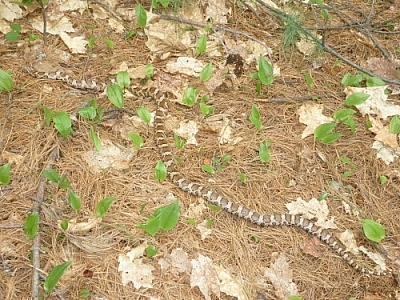We saw this milk snake during a week-long trek on the La Cloche Silhouette Trail in Killarney Provincial Park:

And this milk snake was spotted just over a month later in Samuel de Champlain Provincial Park, near Mattawa:

These beauties may look a little like rattlers, but milk snakes are actually harmless. They do rattle their tails against fallen leaves and underbrush in an attempt to imitate the rattlesnake, and hopefully scare off potential predators, but don’t be fooled.
Figuring it out isn’t hard. Of course, no sudden movements.
- Just try to take a look at the tail and check for a rattle.
- If the tail isn’t visible, or if a rattle’s possibly fallen off, then take a closer look at the head. There’s a clearly identifiable Y or X marking on top of a milk snake’s head and neck (as you can see on the second image above).
- And if you need further proof, the milk snake’s spots have a dark outline; the rattler’s don’t.
- It’s not advised to get close enough to see whether there are venom pits in the cheeks!
- But do observe the shape of the head — all venomous snakes have triangular or diamond-shaped heads; many non-venomous snakes such as milk snakes have longer, slimmer heads.
Popular in Travel & Trekking




Search Niackery
×